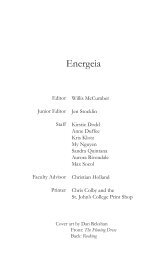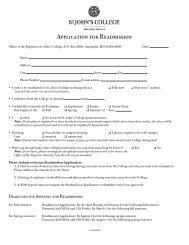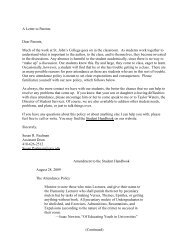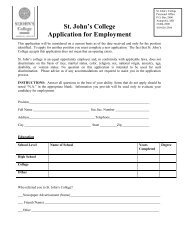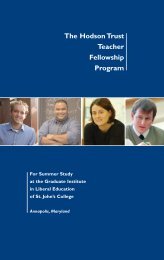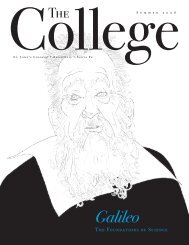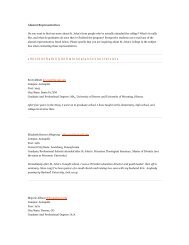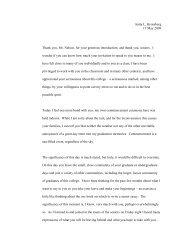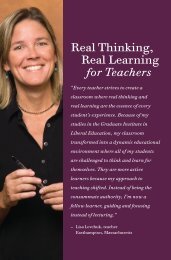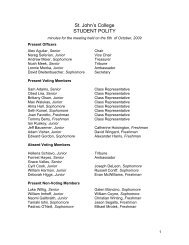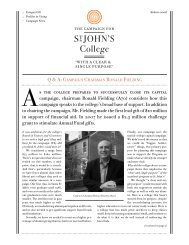Magazine - summer 03 - St. John's College
Magazine - summer 03 - St. John's College
Magazine - summer 03 - St. John's College
You also want an ePaper? Increase the reach of your titles
YUMPU automatically turns print PDFs into web optimized ePapers that Google loves.
{Alumni Profile}<br />
31<br />
This painstaking research was what Chaski<br />
went back to when a homicide detective<br />
named W. Allison Blackman brought her a<br />
computer disk with suicide notes allegedly<br />
written by Michael Hunter, a young man<br />
found dead of a lethal combination of drugs<br />
injected into his arm. Blackman didn’t have<br />
much to go on when he came to Chaski and<br />
asked if she could examine the note and<br />
other writing samples from Hunter to determine<br />
if he had really written the suicide note.<br />
“I know how to analyze syntax and I know<br />
how to find patterns,” she told Blackman.<br />
“I’ll try it and we’ll see.”<br />
Chaski looked at writing samples for<br />
Hunter and his two roommates, including a<br />
young medical student named Joseph Mannino,<br />
who had easy access to the drugs in<br />
Hunter’s system. Chaski found that patterns<br />
in the suicide note—particularly the use of<br />
conjunctions—were strikingly similar to<br />
those of Mannino, who was involved in a<br />
three-way affair with Hunter and a third<br />
roommate. The suicide notes were marked by<br />
conjunctions between sentences. Samples of<br />
Hunter’s authentic writing included more<br />
conjunctions between non-sentence phrases.<br />
Police eventually arrested Mannino. After<br />
a three-week trial, he was convicted of involuntary<br />
manslaughter and sentenced to seven<br />
years in prison.<br />
After consulting with the local district<br />
attorney’s office on another case (identifying<br />
the author of an anonymous threatening letter),<br />
Chaski knew she had found something<br />
more satisfying and more challenging than<br />
an academic career. “At <strong>St</strong>. John’s, we talk a<br />
lot about the examined life. I just wasn’t<br />
happy as an academic. It seemed that the primary<br />
role of professors was to get away from<br />
the students,” she says.<br />
She secured a fellowship at the National<br />
Institute of Justice (the research arm of the<br />
U.S. Justice Department) and set about finetuning<br />
a method to distinguish one author<br />
from another based on syntactic patterns. “I<br />
was the only one doing any research independent<br />
of litigation,” Chaski says.<br />
As part of her research, Chaski set about<br />
examining every method already employed<br />
in language identification. She demonstrated<br />
that analyzing language based on the<br />
spelling, punctuation, and grammatical<br />
errors was not good enough to determine<br />
individuality in writing. “I’m really against<br />
the prescriptive, stylistics method because<br />
what pops out to people as odd is not a pattern,<br />
it’s just what’s popping out,” she<br />
explains. “It’s like Plato’s cave—you can’t<br />
know the light until you know the shadow,<br />
and you have to have them both. In DNA<br />
analysis, if you’re looking for a chromosomal<br />
anomaly, you have to have the whole<br />
pattern. That’s where you start in syntactic<br />
analysis. Every document is analyzed for<br />
every syntactic pattern and nothing is left<br />
out. That way you can find out if something<br />
that seems unusual in a piece of writing<br />
really is unusual.”<br />
Similarly, the type of analysis scholars<br />
undertake in trying to determine the authorship<br />
of something like a Shakespeare play or<br />
a Biblical text (content analysis, vocabulary<br />
“It’s like Plato’s cave—<br />
you can’t know the light<br />
until you know the<br />
shadow, and you have<br />
to have them both.”<br />
Carole Chaski, A77<br />
richness, the complexity of sentences) is not<br />
suited to forensic linguistics, where documents<br />
conveying death threats or ransom<br />
demands are usually short and to the point.<br />
Chaski has spent the last decade or so<br />
refining and applying a scientific method for<br />
syntactic analysis that is rooted in linguistic<br />
theory and validated by statistical testing.<br />
Each analysis begins with taking texts apart<br />
and labeling each word for its part of speech,<br />
then taking phrases within the sentences and<br />
parsing those. “Once the phrases are all<br />
determined, I categorize them into two<br />
types: marked and unmarked. Unmarked are<br />
phases that are so common, they don’t stand<br />
out—‘it’s in the car.’ Marked are those that<br />
are more infrequent or more remarkable—<br />
‘it’s in the car, in the garage, attached to<br />
the house.’’’<br />
Next, Chaski determines the frequency of<br />
marked and unmarked phrases in the writing<br />
samples. Those numbers are fed into computer<br />
programs that yield three different<br />
statistical analyses. The first two methods,<br />
discriminate function analysis and logistic<br />
regression, seek a clear division between the<br />
questioned document and the other known<br />
writing samples in her pool. The third test,<br />
hierarchical cluster analysis, seeks similarities<br />
by “clustering” similar samples into the<br />
same pool.<br />
“Everybody starts out in a pool of potential<br />
authors. If the statistical procedures<br />
show there’s a significant difference, people<br />
are excluded. If I can’t find any difference<br />
between a suspect’s writing sample and the<br />
evidence document, that’s what my report<br />
will say,” Chaski says, adding, “I never claim<br />
that only one person in the world could have<br />
written something.”<br />
Several years ago, Chaski left Washington<br />
for Georgetown, Del., where she founded the<br />
Institute for Linguistic Evidence, of which<br />
she is executive director. Along with continuing<br />
research, lecturing, and writing about<br />
her methods, Chaski has served as a consultant<br />
in a number of intriguing cases where her<br />
research influenced the outcomes. In one<br />
Annapolis case, the founder of a firm that<br />
developed environmental technology was<br />
sued by a former employee who wanted a<br />
significant share of the profits reaped from<br />
the company’s product. However, the company’s<br />
owner suspected the man had written<br />
damaging letters to potential customers.<br />
“The lawyers for the defendant came to<br />
me and they were already convinced that it<br />
was this engineer. In this case, the pool was<br />
limited to those who worked for the company—only<br />
they had the technical knowledge to<br />
write the letters, ” Chaski explains. Her<br />
analysis proved the defendant correct, and<br />
on that basis, the judge overruled the jury<br />
verdict to give the fired engineer the small<br />
sum the jury had agreed upon.<br />
In another recent civil case, Chaski<br />
determined that a woman claiming sexual<br />
harassment in her workplace was the<br />
author of e-mails that indicated the relationship<br />
between her and her supervisor<br />
was consensual. Chaski also showed that a<br />
federal employee who was fired for writing<br />
racist e-mails was very probably the author<br />
of those missives. In other cases, Chaski’s<br />
work has taken her into state and federal<br />
courts, where her testimony has passed<br />
successfully through the scrutiny of<br />
evidence hearings.<br />
Chaski believes it’s possible for someone<br />
to succeed in imitating another’s writing to<br />
a degree, but that it’s impossible to suppress<br />
one’s own style completely. “Language<br />
is meant to be meaning-centered, not<br />
syntax-centered. Syntax is fundamental, it’s<br />
what makes language efficient. But it’s very<br />
abstract, very automated. If we thought<br />
about it, we’d go nuts—‘how many prepositional<br />
phrases did I just write?’—and not<br />
actually be able to communicate.”<br />
Given her <strong>St</strong>. John’s education, it’s not<br />
really odd that Chaski was drawn to forensic<br />
linguistics. “That’s because Johnnies learn to<br />
think about, and talk about, language as language,”<br />
says Chaski. x<br />
{ The <strong>College</strong> • <strong>St</strong>. John’s <strong>College</strong> • Fall 2004 }




